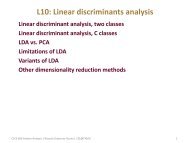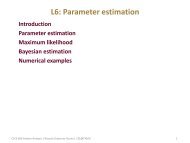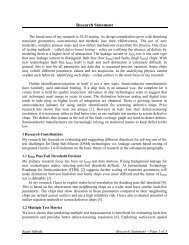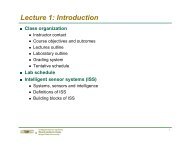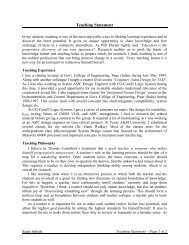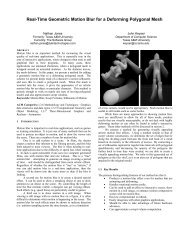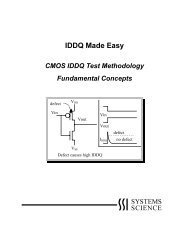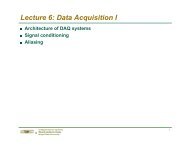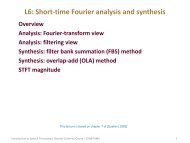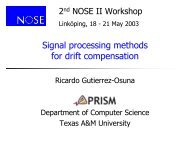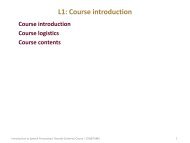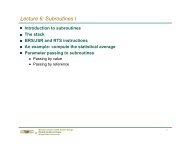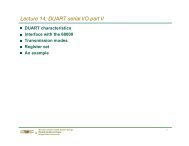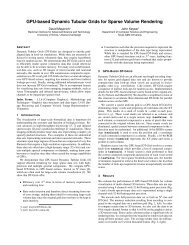presentation slides - Texas A&M University
presentation slides - Texas A&M University
presentation slides - Texas A&M University
Create successful ePaper yourself
Turn your PDF publications into a flip-book with our unique Google optimized e-Paper software.
“Research is to see what everyone else has seen<br />
and think what no one else has thought.”<br />
Albert Einstein
Integrated Circuit<br />
Outlier Identification by<br />
Multiple Parameter Correlation<br />
Sagar Sabade<br />
Department of Computer Science<br />
<strong>Texas</strong> A&M <strong>University</strong>, MS 3112<br />
College Station, TX 77843-3112<br />
E-mail: sagar@tamu.edu
Outline<br />
Introduction<br />
Problem Definition<br />
Prior Work<br />
Research Goals<br />
Research Plan<br />
Summary
14 mm<br />
Test: Needle Search In Haystack<br />
Intel ® Pentium 4 chip layout<br />
© Intel Corporation<br />
14 mm<br />
Particle<br />
~130 nm<br />
130 nm technology<br />
Miles of copper interconnect<br />
42 million transistors
Smaller Needle, Bigger Haystack<br />
© IBM Corporation
Semiconductor Economics 101<br />
Cost – the prime drive for technology<br />
Manufacturing cost/transistor falls rapidly<br />
higher performance/cost ratio<br />
Complexity increasing with each technology<br />
advancement<br />
Test cost falls slowly<br />
Increasing test cost contribution to overall cost<br />
Tester time extremely valuable<br />
Important to find defective chip early in test cycle or<br />
manufacturing flow
Basic Testing Methodology<br />
Input<br />
1<br />
0<br />
1<br />
1<br />
0<br />
1<br />
0<br />
1<br />
Apply inputs to<br />
excite the defect<br />
1<br />
0<br />
defect<br />
(Fault-free)<br />
Output<br />
1<br />
1<br />
1<br />
0<br />
1<br />
0<br />
1<br />
0<br />
and propagate its<br />
effect to the output<br />
(Faulty)<br />
Output<br />
1<br />
0<br />
1<br />
0<br />
1<br />
0<br />
0<br />
0<br />
Defect detected<br />
only if output<br />
different from<br />
fault-free output
So Many Defects, So Little Time<br />
Billions of possible defects<br />
Fortunately have similar effect on electrical<br />
characteristics<br />
Modeled using higher level of abstraction called<br />
“fault”<br />
Defect physical (e.g. short between lines)<br />
Fault electrical (e.g. increased current)<br />
Many (possible) defects map to the same fault
IC Testing Methods<br />
Functional testing (Black box)<br />
Verify “correctness” of chip, conformance to<br />
specifications<br />
Exponential test time<br />
Structural testing (White box)<br />
Verify “integrity” of chip structure<br />
Too abstract, no implicit confidence about function<br />
Defect-based testing<br />
Verify absence of defect<br />
If no defects detected, chip should be fault-free<br />
Test methods complementary in nature
Defect-based Test Types<br />
Boolean test<br />
Can distinguish between faulty or fault-free<br />
chips<br />
Continuous parameter test<br />
No clear faulty/fault-free distinction<br />
Leakage current (I DDQ ) test
Leakage Current (I DDQ) Test<br />
Primary measurement leakage current<br />
Current drawn from the supply when the<br />
inputs are stable<br />
Can be measured at power supply (V DD ) line<br />
or at the ground (called I SSQ )
Basics of I DDQ Testing<br />
Premise: Fault-free CMOS chips have low<br />
leakage<br />
V DD<br />
Defect<br />
Input Output<br />
I DD<br />
Input<br />
Output<br />
I DD<br />
Low fault-free I DDQ<br />
High defective I DDQ<br />
Time
Defect Types<br />
Active (pattern-dependent) defect<br />
Leakage current high for some but not all<br />
patterns<br />
e.g. gate-to-source short, gate oxide short<br />
Passive (pattern-independent) defect<br />
High leakage current for all input patterns<br />
e.g. V DD -GND short
Advantages of I DDQ Testing<br />
Simple, intuitive<br />
No propagation requirements<br />
100% observability<br />
Fortuitous detection<br />
Fewer vectors needed for higher fault detection<br />
capability<br />
Detects several defect types<br />
GOS, stuck-on, punch-through, bridges<br />
Detects some latent defects<br />
Useful for screening low-reliability chips
Conventional I DDQ Testing<br />
Single threshold method<br />
Threshold decided using circuit simulations or<br />
empirically<br />
I DDQ<br />
Rejected chips<br />
Accepted chips<br />
Chip<br />
Threshold
Technology Impact on I DDQ Test<br />
Reduced transistor geometries<br />
Increases leakage current exponentially<br />
Increased process variations<br />
Cannot distinguish between faulty and fault-free<br />
leakage currents using a single threshold<br />
Small threshold rejects too many good chips<br />
Yield loss (lost revenue)<br />
High threshold accepts too many flawed chips<br />
Test escapes (customer returns)
ITRS Projections for I DDQ<br />
Year Gate Length (nm) I DDQ<br />
2001 90 30 – 70 mA<br />
2003 65 70 – 150 mA<br />
2005 45 150 – 400 mA<br />
2008 35 400 mA – 1.6A<br />
2011 25 1.6 – 8 A<br />
2014 15 8 – 20 A<br />
For high-performance microprocessor circuits<br />
Source: Intl. Technology Roadmap for Semiconductors (ITRS) 2001
I DDQ Test in Deep Sub-Micron<br />
Earlier Technologies<br />
Threshold<br />
Fault-free Faulty<br />
I DDQ<br />
Deep Sub-Micron Technologies<br />
Test Escapes<br />
Threshold<br />
Fault-free Faulty<br />
I DDQ<br />
Yield Loss
I DDQ and Defect Severity<br />
Frequency<br />
100<br />
10<br />
1<br />
Fault-free<br />
Subtle defect<br />
0.1 1 10 100 1000<br />
ID DQ (uA)<br />
Fatally flawed<br />
Gross defect
I DDQ Too Important to Lose<br />
Important component of test suite<br />
Capable of detecting some unique defects<br />
When used with other test methods, it can reduce test<br />
escapes/defect level<br />
Detects some latent defects<br />
Useful for screening low reliability chips<br />
Useful as an alternative to burn-in (BI)<br />
BI less effective and expensive for DSM technologies<br />
Reduced voltage and temperature acceleration
I DDQ Only a Part of the Puzzle<br />
Increased<br />
Leakage<br />
Increased<br />
Test cost<br />
Inaccurate<br />
Fault models<br />
&<br />
New<br />
Defect<br />
Mechanisms<br />
Process<br />
Variability<br />
Test time/data<br />
Reduction &<br />
Insufficient<br />
Fault coverage<br />
Reliability<br />
Screens losing<br />
effectiveness
Research Focus<br />
This research focuses on using statistical outlier<br />
rejection methods for identifying flawed chips<br />
that might lead to functional failure.<br />
outlier
Why Use Outlier Detection?<br />
Continuous parameter spectrum<br />
Must distinguish flawed chips from “fatally”<br />
flawed ones<br />
Flawed chips show different behavior than<br />
others<br />
Appear as an “outliers”<br />
Outlier detection useful for differentiation
What is an Outlier?<br />
Outlier<br />
A chip that exhibits markedly different<br />
parameter(s) or variation in parameter(s)<br />
compared to other chips<br />
Improving confidence in differentiating<br />
“true” outliers is the motivation for this<br />
research
Outlier Identification Methods<br />
Reliance on properties of standard<br />
distributions<br />
Mean, standard deviation, median, range<br />
Various methods<br />
Z-scores test<br />
Chauvenet’s criterion<br />
Tukey method<br />
Median of Absolute Deviations (MAD) test
Why is Outlier Detection Difficult?<br />
Outliers affect properties of the distribution<br />
Several orders of magnitude variation in<br />
fault-free I DDQ itself<br />
Makes difficult to distinguish between a “true”<br />
outlier and an “apparent” outlier<br />
Outliers chips are functionally okay<br />
Manufacturer’s dilemma (yield loss vs.<br />
quality)
Frequency<br />
No Silver Bullet<br />
180<br />
160<br />
140<br />
120<br />
100<br />
80<br />
60<br />
40<br />
20<br />
0<br />
Frequency<br />
180<br />
160<br />
140<br />
120<br />
100<br />
80<br />
60<br />
40<br />
Frequency<br />
180<br />
160<br />
140<br />
120<br />
100<br />
80<br />
60<br />
N = 176<br />
Mean 2.5 µA<br />
STD 8.3<br />
20<br />
0<br />
0 500 1000 1500<br />
40<br />
20<br />
2000 2500<br />
0<br />
0 2<br />
N = 151<br />
4<br />
Mean 0.44 µA<br />
IDDQ (µA)<br />
STD 0.18<br />
6 8<br />
IDDQ (µA)<br />
0<br />
0 20 40 60<br />
N = 197<br />
Mean 678 µA<br />
STD 2142.65<br />
N = 179<br />
Mean 19.58 µA<br />
STD 176.35<br />
outliers<br />
0 2000 4000 6000 8000<br />
IDDQ (µA)<br />
Frequency<br />
20<br />
10<br />
8<br />
6<br />
4<br />
2<br />
IDDQ (µA)<br />
Frequency<br />
Wafer level data for a vector<br />
10<br />
N = 166<br />
Mean 0.84 µA<br />
STD 1.43<br />
0<br />
0.0 0.2 0.4 0.6 0.8 1.0 1.2 1.4<br />
IDDQ (µA)
Suggested Solution Methods<br />
Approach 1<br />
Reduce fault-free I DDQ<br />
Makes identifying faulty I DDQ easier<br />
Approach 2<br />
Estimate fault-free I DDQ accurately<br />
Approach 3<br />
Reduce variation in fault-free I DDQ data<br />
Makes faulty I DDQ “stand out”<br />
Category known as I DDX
Approach 1:<br />
Reducing Fault-free I DDQ<br />
Reduce temperature<br />
Too expensive, slow, impractical<br />
Less effective for future technologies<br />
Reverse (back) body bias<br />
Technology change, inflexible<br />
Less effective due to limited backbias voltage<br />
Silicon-On-Insulator (SOI)<br />
Different technology, learning curve<br />
Multiple-threshold transistors<br />
Performance tradeoff, less effective in future
Approach 2:<br />
Estimating Fault-free I DDQ<br />
Model-based estimation<br />
Usually switch-level (transistor) modeling<br />
Mostly design-specific<br />
Time consuming for large chips<br />
Does not address process variation issue<br />
very well<br />
Empirical estimation of fault-free I DDQ<br />
Requires extensive analysis of data
Die 1 I DDQ Variation<br />
Level 2<br />
Level 1
Die 2 I DDQ Variation<br />
Small spread
Die 1 and Die 2 I DDQ Variation<br />
Die 1 readings<br />
Die 1<br />
Die 2
Die 1, 2 and 3 I DDQ Variation<br />
Die 3<br />
Die 3 levels<br />
Die 2<br />
Die 1<br />
Is Die 1 really<br />
Defective?
Four Dice From a Wafer<br />
Difficult to determine which of these dice are<br />
Defective and which ones are fault-free.
Approach 3:<br />
I DDX Test Methods<br />
Current Signature<br />
Delta-I DDQ<br />
Histogram-based Method<br />
Correlation with other parameters<br />
Wafer XY location<br />
Frequency (F max)<br />
Flush delay
Current Signature [Gattiker,Maly]<br />
Signature – sorted I DDQ measurements<br />
A chip with active defect shows a “step” or<br />
“jump” in the signature<br />
Indicates multiple paths current can take<br />
Fault-free chip shows smooth signature<br />
Also true for passive defects<br />
Cannot screen passive and subtle active<br />
defects
Current Signatures Example<br />
Passive<br />
Defect?<br />
Active<br />
Defect<br />
Faulty/<br />
Fault-free?<br />
Fault-free
Differential/Delta I DDQ [Thibeault]<br />
Differences (deltas) in consecutive<br />
readings small for a fault-free chip<br />
Background leakage gets cancelled<br />
Cannot screen passive defects<br />
Less effectiveness in future [Krusemann]
Histogram-based Analysis<br />
Frequency<br />
Reduce σ,<br />
Mean ~ 0<br />
0<br />
Delta-I DDQ<br />
I DDQ values<br />
I DDQ
Current Ratios [Maxwell et al.]<br />
CR relatively constant for fault-free chips<br />
CR = Max I DDQ<br />
Min I DDQ<br />
Measure I DDQ for the “minimum I DDQ<br />
vector”<br />
Set limits on all other vectors dynamically<br />
Min. I DDQ vector changes from chip to chip
Current Ratios Example<br />
Courtesy: Peter Maxwell, Agilent Technologies
Threshold Selection Challenge<br />
Max I DDQ / Min I DDQ<br />
1000<br />
100<br />
10<br />
1<br />
I DDQ > 5 µA<br />
I DDQ < 5 µA<br />
1 10 100 1000 10000<br />
Chip number<br />
Which is the<br />
“correct”<br />
threshold?
Outlier Identification by Correlation<br />
Correlation useful for estimating fault-free I DDQ<br />
Can be used for outlier identification<br />
Different methods<br />
Vector-to-vector correlation [Unni et al.]<br />
Die-to-die correlation<br />
Die XY position on wafer [Daasch et al.]<br />
Other parameters<br />
F max [Keshavarzi et al.]<br />
Flush delay [Sabade et al.]
Motivation: Spatial Correlation<br />
Similar process conditions for neighboring<br />
chips on a wafer<br />
Fault-free chip parameters are expected to<br />
be similar<br />
A sudden change in any parameter is<br />
indicative of anomalous behavior<br />
Likely defective [Singh et al.]<br />
Called “spatial outliers”
Spatial Outlier Example<br />
IDDQ (µA)<br />
50<br />
40<br />
30<br />
20<br />
10<br />
0<br />
2<br />
4<br />
6<br />
8<br />
X Coordinate<br />
10<br />
12<br />
Spatial outliers<br />
14<br />
16<br />
2<br />
101214161820<br />
8<br />
6<br />
4<br />
Y Coodinate
Local Neighborhood Definition<br />
Center die
Estimation of Fault-free I DDQ<br />
Use neighboring chips’ I DDQ for estimating<br />
fault-free I DDQ of the center die<br />
If actual I DDQ is higher, center die is likely to<br />
be defective<br />
If actual I DDQ is lower, neighbor die could be<br />
defective<br />
How high is high? How low is low?<br />
Threshold setting does not disappear
Correlation Methods<br />
Spatial/plane fit<br />
Neighbor Current Ratios (NCR)<br />
Immediate Neighbor Difference I DDQ Test<br />
(INDIT)<br />
Correlation with flush delay
Plane Fit<br />
I DDQ function of neighboring dice I DDQ and<br />
die’s XY position on wafer<br />
First reject gross outliers<br />
Linear regression<br />
Z (I DDQ) = A .x + B .y + C<br />
I DDQ<br />
Best fit plane<br />
X<br />
Y<br />
wafer
Neighbor Current Ratios (NCR)<br />
Two neighboring chips should have similar<br />
I DDQ for identical vectors i<br />
NCR (i) =<br />
I DDQ die 1 (i)<br />
I DDQ die 2 (i)<br />
~ 1<br />
Process variations cause NCRs to vary<br />
Mean value close to 1<br />
High NCR indicates defective die (Die 1)
NCR Illustration<br />
Max NCR<br />
1200<br />
1000<br />
800<br />
600<br />
400<br />
200<br />
0<br />
2<br />
4<br />
6<br />
X<br />
8<br />
10<br />
12<br />
14<br />
16<br />
2<br />
101214161820<br />
8<br />
6<br />
4<br />
Y<br />
Obvious spatial outliers
Max NCR<br />
Max NCR<br />
CR/NCR Insights<br />
100<br />
10<br />
1<br />
0.1<br />
0.01<br />
0.001<br />
0.0001<br />
0.00001<br />
100<br />
10<br />
1<br />
0.1<br />
0.01<br />
0.001<br />
All pass – All pass<br />
1 10 100<br />
CR<br />
1 10 100<br />
CR<br />
All pass – Any fail<br />
Max NCR<br />
Max NCR<br />
1000<br />
100<br />
10<br />
1<br />
0.1<br />
0.01<br />
0.001<br />
0.0001<br />
1000<br />
100<br />
10<br />
1<br />
IDDQ fail – IDDQ fail<br />
1 10 100 1000 10000<br />
CR<br />
1 10 100 1000<br />
CR<br />
IDDQ fail – Boolean fail
Healer Chips and CR/NCR<br />
Healer – a chip that shows elevated I DDQ<br />
before BI and reduced I DDQ after BI<br />
Need more careful analysis<br />
Max NCR<br />
1000<br />
100<br />
10<br />
1<br />
0.1<br />
0.01<br />
0.001<br />
1 10 100 1000<br />
CR
Immediate Neighbor Difference<br />
I DDQ Test (INDIT)<br />
Ratios may pass some outliers<br />
IND (i) = IDDQ Die 1 (i) – IDDQ Die 2 (i) ~ 0<br />
Differences in I DDQ for same vectors ~ 0<br />
Process variations cause variation
Why Multi-parameter Test?<br />
I DDQ test alone not enough<br />
Pass/fail decision difficult and prone to error<br />
Can result in yield loss/test escapes<br />
Need higher confidence in detecting flawed<br />
chips<br />
Defect detection capability diminishing for each<br />
test method in isolation<br />
Defect detection harder with each technology node
I DDQ & Flush Delay Correlation<br />
Flush delay (ns)<br />
500<br />
480<br />
460<br />
440<br />
420<br />
400<br />
380<br />
360<br />
340<br />
0.01 0.1 1 10 100<br />
Minimimum IDDQ (uA)<br />
Flush delay (ns)<br />
490<br />
470<br />
450<br />
430<br />
410<br />
390<br />
370<br />
350<br />
0 0.2 0.4 0.6 0.8 1<br />
Min IDDQ (uA)
Research Goals<br />
Identify outlier chips<br />
Distinguish between real and seemingly<br />
outliers<br />
Exploit wafer-level spatial dependence<br />
Correlate multiple test measurements<br />
Vector-to-vector for the same chip<br />
Across multiple chips, wafers or lots<br />
Evaluate possibility for burn-in reduction
Research Plan - I<br />
Extensive analysis of SEMATECH data<br />
Evaluate different ideas<br />
Correlate with BI results to validate methods<br />
Data rather outdated (0.6 micron)<br />
Recent data obtained from LSI Logic<br />
No BI data available<br />
How to validate methods?<br />
Proposal sent to <strong>Texas</strong> Instruments<br />
Discussed with Philips, IBM, Sony
Research Plan - II<br />
Use advanced statistical methods<br />
Factor analysis<br />
Understand underlying process variations, compare<br />
estimated I DDQ with model<br />
Evaluate different outlier identification methods<br />
Chauvenet’s criterion, Tukey method, Median of<br />
Absolute Deviations (MAD), etc.<br />
Evaluate use of mean vs. median<br />
Estimate yield loss/defect level improvements
Research Contributions<br />
Systematic identification of outlier chips<br />
Neighboring chips’ parameter-based<br />
estimation and statistical analysis for<br />
defective chip screening<br />
Insight into underlying process variations<br />
Possible burn-in reduction or elimination<br />
Test cost reduction
Research Benefits<br />
Early detection of<br />
defective chips<br />
or latent defects<br />
Burn-in reduction<br />
Or<br />
Elimination<br />
Increased Profit<br />
Understanding process<br />
glitches, variations<br />
& yield excursions<br />
Test cost reduction,<br />
Reduced DPM<br />
Reduced customer returns
Summary<br />
Defect-based VLSI testing faces difficult<br />
challenges; I DDQ test loses its effectiveness<br />
Single parameter testing loses its effectiveness<br />
in screening faulty chips<br />
Correlating multiple test measurements<br />
necessary to screen true outliers<br />
Wafer-level test can be useful in reducing test<br />
time and overall test cost<br />
Has potential to reduce burn-in
Questions?
Backup Slides
Pattern Dependent Defect<br />
Input Output IDDQ<br />
1 0 low<br />
I/P O/P<br />
0 1 high Defect Detected!<br />
Gate to source short
I/P<br />
Pattern Independent Defect<br />
O/P<br />
Input Output IDDQ<br />
1 0 high<br />
0 1 high<br />
Resistive bridge
Short Channel Effect<br />
Gate begins to lose<br />
Control over the channel<br />
Effective V th reduced<br />
(V t Roll-off)<br />
V th<br />
Gate Length (um)
Process Variation Levels<br />
Frequency<br />
Parameter Value<br />
Lot to lot<br />
Wafer to wafer<br />
Inter die (same wafer)<br />
Intra-die (vector)
VLSI Technology Advancement<br />
Reduced transistor geometries<br />
Higher transistor counts<br />
Higher levels of integration (SoC designs)<br />
Increasing device complexity (9 metal layers)<br />
Mixed signal design (more analog)<br />
New materials (low-K, high-K)<br />
Lower supply and threshold voltages<br />
Higher leakage currents and power dissipation
Technology Impact on Testing<br />
Reduced transistor geometries<br />
Increased process variations<br />
New defect mechanisms<br />
Inaccurate fault models<br />
Higher levels of integration<br />
Reduced observability and controllability of defects<br />
Higher leakage currents<br />
Unable to distinguish faulty currents<br />
Reduced voltage, increased temperature<br />
Reduced effectiveness of reliability screens
Impact on I DDQ Testing<br />
Reduced transistor geometries<br />
Reduced supply voltages to avoid gate oxide<br />
breakdown<br />
Necessary to reduce threshold voltage for<br />
performance requirements<br />
Increases leakage current exponentially<br />
Cannot distinguish between faulty and fault-free<br />
leakage currents using a single threshold<br />
Unacceptable yield loss and/or test escapes<br />
Large process variations make it worse!
Scaling Implications on IOFF<br />
I OFF<br />
(nA/um)<br />
ITRS Projections for High-performance Microprocessors<br />
Target Supply Voltage (V DD )
CMOS Scaling Fundamentals<br />
Scaling to 1/K reduces the drain current<br />
Propagation delay is reduced to 1/K.
Non-uniform Scaling Trends<br />
Source : ITRS 2001<br />
T ox scales faster than<br />
V DD<br />
Increased electrical<br />
field<br />
Performance depends<br />
on V DD -V t<br />
V t scales slower than<br />
V DD due to Boltzmann<br />
statistics
I DDQ Variation (All Chips)<br />
Max I DDQ (µA)<br />
10000<br />
1000<br />
100<br />
10<br />
1<br />
0.1<br />
0.01<br />
0.01<br />
0.1<br />
1<br />
Min I DDQ (µA)<br />
10<br />
100<br />
“All pass” chips<br />
1000<br />
10000<br />
0.01<br />
0.1<br />
1<br />
10<br />
10000<br />
1000<br />
100<br />
Med I DDQ ( µA)
“All Pass” Chips I DDQ Variation<br />
Max I DDQ (µA)<br />
5<br />
4<br />
3<br />
2<br />
1<br />
0.01<br />
0.1<br />
Min I DDQ (µA)<br />
1<br />
1<br />
2<br />
3<br />
4<br />
Med I DDQ (µA)<br />
5<br />
Several outliers<br />
Are all defective?
Actual I DDQ Distribution<br />
Optimum Threshold?
Leakage Current Components<br />
Input = 1<br />
Output = 0<br />
P + P +<br />
n + n +<br />
I G<br />
I DW<br />
Reverse biased PN junction leakage<br />
Subthreshold current (weak inversion)<br />
Gate Induced Drain Leakage (GIDL)<br />
Drain Induced Barrier Lowering (DIBL)<br />
Punch-through Leakage<br />
Tunneling leakage through gate oxide<br />
I D<br />
IDS IDIBL IPT IGIDL P +<br />
n +<br />
V DD<br />
P + N-well<br />
substrate
Leakage Current Components<br />
Input = 0<br />
Output = 1<br />
P + P +<br />
n + n +<br />
IDS<br />
I DW<br />
Reverse biased PN-junction leakage<br />
Subthreshold leakage<br />
ID<br />
Punch-through leakage<br />
Gate Induced Drain Leakage (GIDL)<br />
IG<br />
P +<br />
Drain Induced Barrier Lowering (DIBL)<br />
n +<br />
V DD<br />
P + N-well<br />
substrate<br />
Tunneling leakage
Major I DDQ Components<br />
I D<br />
(Log scale)<br />
GIDL<br />
Weak inversion<br />
& Junction leakage<br />
0 V G<br />
DIBL<br />
VD = 4.0 V<br />
VD = 2.7 V<br />
V D = 0.1 V
Do We Need a Smart Tester?<br />
“Automatic Test Equipment (ATE) is a<br />
misnomer. It should be called Automatic<br />
Measuring Equipment (AME). …We need<br />
statistical methods to discriminate faulty<br />
chips [from fault-free ones].”<br />
- Robert Madge (LSI Logic) at Industrial Test<br />
Challenges talk at Intel in May 2002
Two Signature Types<br />
IDDQ (uA)<br />
54.5<br />
54.0<br />
53.5<br />
53.0<br />
52.5<br />
52.0<br />
51.5<br />
51.0<br />
50.5<br />
0 50 100 150 200<br />
Number<br />
Pattern Dependent<br />
Current Signature<br />
IDDQ (uA)<br />
15<br />
14<br />
13<br />
12<br />
11<br />
10<br />
9<br />
8<br />
7<br />
6<br />
5<br />
4<br />
3<br />
2<br />
1<br />
0<br />
0 50 100 150 200<br />
Number<br />
Pattern Independent<br />
Current Signature<br />
(Background leakage)
Radial I DDQ Variation<br />
IDDQ (uA)<br />
10<br />
1<br />
0.1<br />
I DDQ for a single vector shown<br />
0 2 4 6 8 10 12<br />
Radial distance (cm)
Handling Defect Clustering<br />
Scratch<br />
226 defects,<br />
Mechanical handling<br />
Defects detected with<br />
Optical in-line tools<br />
Particle contamination<br />
617 defects,<br />
CVD process contamination<br />
Source: Semiconductor Spatial Signature Analysis (SSA)
Correlation: What Does It Mean?<br />
B<br />
A<br />
Positive correlation<br />
B<br />
A<br />
Negative correlation<br />
B<br />
A<br />
No correlation
Why I DDQ Correlates to Delay?<br />
Smaller L eff faster transistor<br />
Smaller L eff more leakage<br />
P<br />
N+ N+<br />
L eff
How Reverse Body Bias Works?<br />
Reverse potential applied to substrate<br />
increases effective V th<br />
This reduces leakage current<br />
Penalty switching speed reduces
All Tests Are Needed<br />
Distribution of package test results for SEMATECH data<br />
5 uA IDDQ Test<br />
Stuck-at Test<br />
P – Pass, F – Fail<br />
P<br />
P<br />
F<br />
F<br />
P P<br />
F F<br />
6 1463 7<br />
14 0 34 1<br />
6 1 13 8<br />
52 36 1251<br />
P F P F<br />
Functional Test<br />
P<br />
F<br />
P<br />
F<br />
Delay Test
Is I DDQ Irreplaceable?<br />
Wafer Test<br />
At-speed<br />
IDDQ Functional IDDQ<br />
2467<br />
343<br />
73<br />
1545<br />
65<br />
3118<br />
35<br />
46<br />
42<br />
34<br />
121<br />
Stuck-at 23<br />
Scan<br />
+ 56 fail only IDDQ + AC scan<br />
+ 4 only functional + stuck-at<br />
98<br />
AC scan<br />
Stuck-at<br />
Scan<br />
521 48 19<br />
12<br />
6<br />
Package Test<br />
31<br />
46<br />
6<br />
25 25<br />
AC scan<br />
+ 36 fail only IDDQ + AC scan<br />
8<br />
7<br />
At-speed<br />
Functional<br />
150000 die at wafer, 76000 dice after package, package values normalized to wafer good parts<br />
Source: Peter Maxwell, Talk at Industrial Test Challenges, May 2002.<br />
4
Fewer Vectors,Higher Coverage<br />
Fault<br />
Coverage %<br />
100<br />
90<br />
80<br />
70<br />
60<br />
50<br />
40<br />
30<br />
20<br />
10<br />
FC by<br />
I DDQ tests<br />
For same FC I DDQ tests require<br />
many fewer vectors than functional test<br />
FC by<br />
functional tests<br />
Vector Number
Optimum Threshold Selection<br />
Frequency<br />
Cost vs. Quality debate<br />
Zero Test Escapes<br />
High<br />
Overkill<br />
Optimum Threshold<br />
I DDQ<br />
Fault-free chips<br />
Faulty chips<br />
Zero Yield Loss<br />
High<br />
Defect Level
Wafer-level Analysis: Advantages<br />
Detection of defective chips at wafer probe<br />
Reduction in test costs and time<br />
Reduced packaging cost/die<br />
Provides insight into understanding underlying<br />
process variations<br />
Useful for detecting process glitches<br />
Different pass/fail criterion for different wafers<br />
Reduce yield penalty for fast and leaky wafers
Values on Logarithmic Scale
Delta I DDQ Illustration<br />
First measurement<br />
I DDQ<br />
Defective<br />
Defective<br />
Vector number<br />
Guard band
Defect Detection<br />
Source: icknowledge.com
Technology Trends
I DDQ Test for Deep Sub-Micron<br />
Yield loss and test escapes inevitable<br />
Frequency<br />
Fault-free<br />
chips<br />
I DDQ<br />
Ith<br />
Faulty chips<br />
Earlier Technologies<br />
Frequency<br />
Fault-free<br />
chips<br />
I th<br />
I DDQ<br />
Faulty chips<br />
Test Escapes Yield Loss<br />
DSM Technologies



